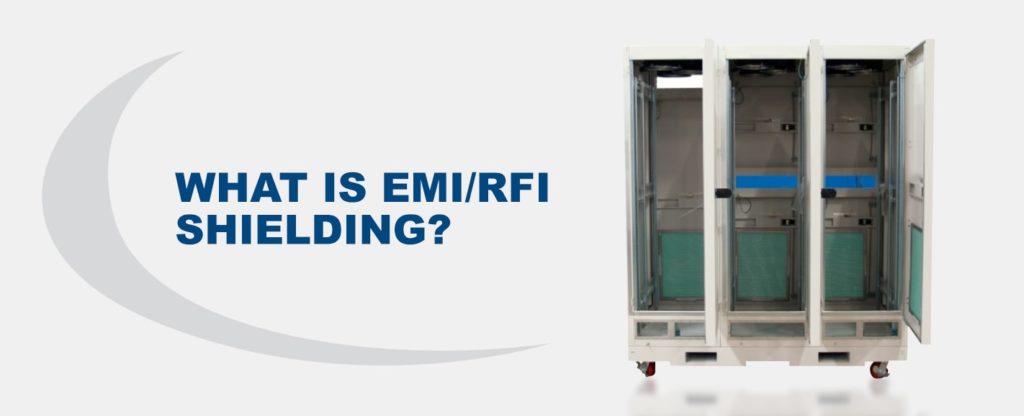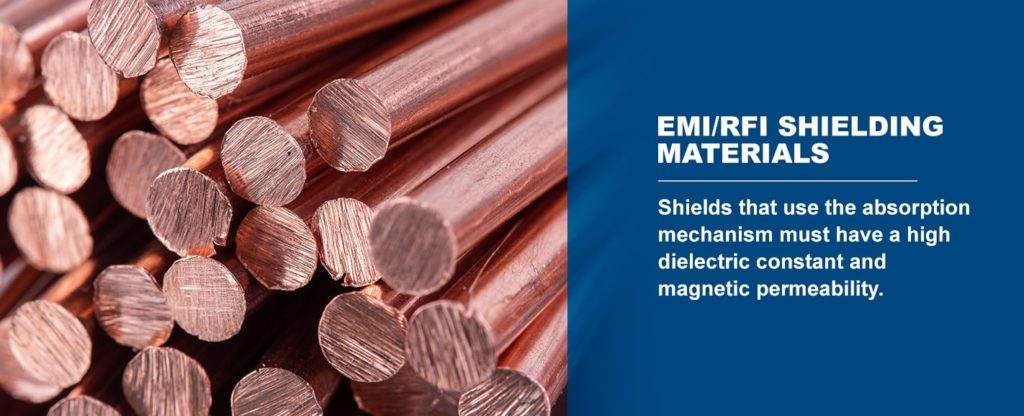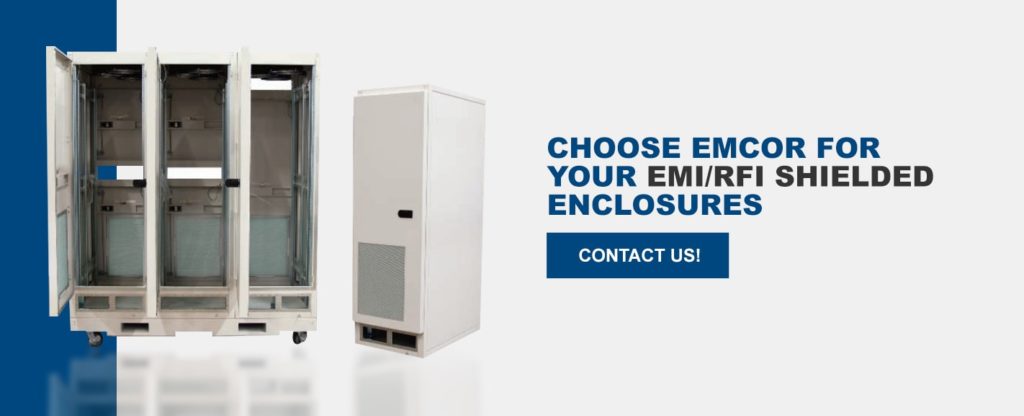Everything You Need To Know About EMI & RFI Shielding

What is EMI/RFI Shielding?
EMI shielding is a technique for protecting devices from strong electromagnetic fields that could interrupt their operation. Laws in many countries require electronic devices to have adequate EMI shielding in place before retailers can put them on shelves.
This process has numerous applications, from military use to data center protection. For example, a primary application for EMI shielding in the defense industry is to increase security by blocking data interception.
Below, we’ll discuss what shielding is in addition to breaking down how it works and why it’s a necessity for most industries.
What Is EMI/RFI?
EMI stands for electromagnetic interference, which is the amount of electronic noise or radio frequency radiation that an electronic device emits. When referring to radio frequency specifically, EMI is known as radio frequency interference (RFI).
There are three primary forms of EMI/RFI:
- Conducted: Occurs in devices that are in constant contact with each other.
- Capacitive: Also referred to as inductive EMI, capacitive interference occurs in devices that are close to each other without touching.
- Radiated: Comes from sources that are far away, like power lines and cellular networks.
While these three forms are distinct, they also work together in a practical sense. For example, radiated emissions will follow conductive paths within a device. Additionally, conducted EMI produced in one part of a device’s circuit board can set off radiated EMI on another part of the board and vice versa.
The sources of EMI/RFI can be either artificial or natural. Common examples include:
- Lightning
- Computers
- Snow or dust storms
- Electric motors
- Cellular networks
- Microwaves
- Wi-Fi and Bluetooth devices
- Power supplies
- Solar flares
Why Is EMI/RFI Shielding Important?
EMI/RFI can be a problem because it can harm your devices and, as a result, your operations. If left unchecked, excessive exposure to EMI can lead to electrical overstress (EOS), which can cause damage to sensitive components and devices. While high-frequency environments like manufacturing plants are especially prone to causing EOS, it can happen to any device that experiences sustained instances of EMI/RFI.
Low-frequency EMI such as that produced by data center power sources can also affect your data integrity. Cables located near these power supplies can conduct unwanted emissions, which can scramble your data and even wipe drives completely. It can also open the door to malicious actors, leading to potential data breaches and other cyber threats.
Therefore, you need to insulate your devices from emitting high levels of EMI and guard your machines against external interference, which can be disastrous in many applications. For example, an EMI wave could interrupt a military communication device, potentially derailing a mission and resulting in tragedy.
The symptoms of electromagnetic interference may include:
- Jammed or distorted signals
- Power fluctuations or sudden outages
- Electrical fast transients (EFTs)
- Circuit damage or total circuit failure
- Shortened life and performance of electronic devices
- Electric shock or burns
EMI/RFI shielding can minimize or even eliminate the above risks. Plus, it can reduce the amount of noise a device emits, which increases its compatibility with the various other devices within a system.
EMI/RFI Shielding Mechanisms
Many EMI shields will utilize more than one mechanism to account for EMI waves of various wavelengths and frequencies.
There are three primary mechanisms for EMI/RFI shielding:
- Absorption: Absorption intercepts the magnetic component of EMI by creating an internal pathway that weakens the interference’s magnetic field lines.
- Reflection: This mechanism uses conduction to redirect the electric component of a wave and cancel it out by generating an opposing field. However, if the enclosure experiences a discontinuity larger than the wavelength of the field, then it will not be as effective.
- Multiple reflections: These shields, often made from composite materials, scatter incoming interference waves and effectively eliminate the threat.
EMI/RFI shields can also come in various forms, such as:
- Enclosures: Enclosures house your entire device and are made from materials that reflect or absorb EMI. You can equip enclosures with gaskets to strengthen their shield or install other seals in the ventilation or power supply openings.
- Shielding gaskets: These components are available in many shapes, sizes, mounts, materials, and seal types. Installing a gasket into your enclosure can create an EMI-proof seal.
- Shielding agents: These metal coatings typically come in acrylic-based sprays, but they can also be paints or brush-on coatings. Applying shielding agents to the plastic around sensitive circuits in an enclosure can help redirect EMI/RFI.
- Filters: EMI filters suppress electromagnetic noise transmitted through conduction while simultaneously allowing the free flow of intentional currents. Many modern electronic devices are legally required to contain EMI filters within their circuitry, but including a filter in your enclosure can cover any devices that may lack this feature.
The correct shield for an application depends on the device or system, the frequency of EMI, and the space available. For example, an unprotected set of servers would benefit from placement in an EMI/RFI shielding enclosure, which could keep them safe from both physical and electrical harm.

EMI/RFI Shielding Materials
The material of a shield determines a shield’s properties and the mechanism it uses to dispel EMI waves. For example, shields that use the absorption mechanism must have a high dielectric constant and magnetic permeability. These properties allow incoming magnetic fields to enter the internal pathway, which cuts them off.
Some common EMI/RFI shielding materials include:
- Copper
- Silver
- Nickel
- Aluminum
- Brass
- Cold-rolled steel
- Phosphorous bronze
These materials are excellent conductors, making them great choices for reflecting EMI waves away from devices.
EMI/RFI Testing
Testing for EMI/RFI is crucial in bringing new products to market, whether they’re products for the general public or for more intensive applications.
EMI and electromagnetic compatibility (EMC) tests measure the amount of unwanted EMI/RFI that a device produces during regular operation. Performing said tests is important because it ensures your device will work near other devices without affecting their function.
Depending on a device’s intended operating environment, an EMI test might simulate one or more of the following situations to assess how the device responds:
- Electromagnetic surges from lightning or other natural phenomena
- Magnetic fields similar to those radiating from electrical wires
- Voltage drops like those caused by power interruptions
- EFTs like those caused by electrical switches or fluorescent lamps
- Discharges similar to static electricity
Various standards are in place for testing products in specific industries. For example, according to the United States Food and Drug Administration (FDA), all medical devices must meet IEC 60601-1-2, a standard from the International Electrotechnical Commission (IEC) that outlines the necessary parameters for EMI on medical devices. If the device fails the tests, it’s not yet suitable for use in a medical setting.
Choose Emcor for Your EMI/RFI Shielded Enclosures
If you’re thinking of investing in EMI/RFI protection for your operation, Emcor Enclosures is here with a solution. We’ve designed our EMI/RFI shielded enclosures with performance in mind. Our enclosures are tested to MIL-STD 285 standards at a certified testing facility and provide two levels of EMI shielding, depending on your requirements.
This clean, seamless piece comes in nine colors and contains 15U to 45U of rack space, complete with mounting rails and unit markings. We can also tailor your enclosure to meet your operation’s specific needs. Contact us today for more information or find a rep near you.
